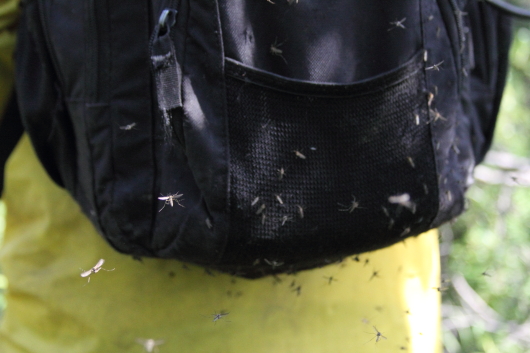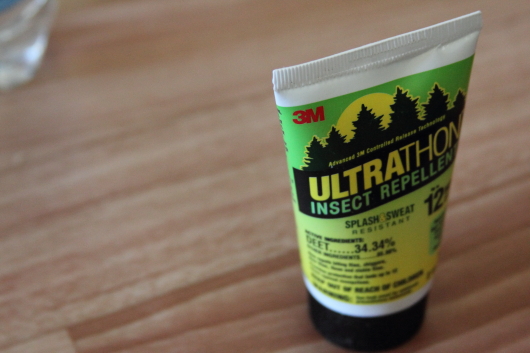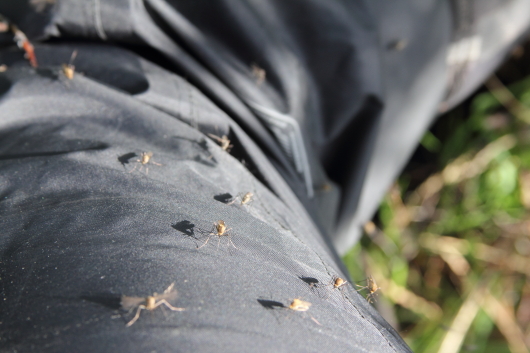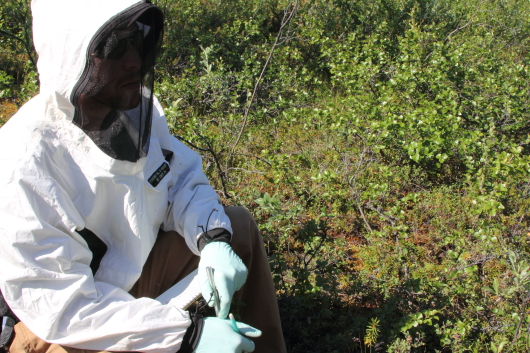Slapping, clapping, waving, scratching—these are common, if not constant signals of life in Siberia.
“Don’t scratch the bites,” someone says, “They’ll go away.” Sure.

Mosquitoes swarmed around the bottom of Eli’s pack as we hiked up and down Y4, a nearby stream, collecting samples and data. The “Y” in Y4 stands for yedoma, a Russian term for the very old (tens-of-thousands of years), thick, carbon rich soil over which the stream flows. © Becky Tachihara
I’ve faced the bloodsuckers in the Florida Keys and the Yucatan, in the North Woods and Newfoundland. I thought they were very bad. I was flat wrong. These are wimpy, effete bug environments, the mosquito minor leagues. Siberia is the bug big time. I’ll bet that the single largest volume of biomass in Siberia has six legs, whining wings and proboscises frantic to puncture. The growing season in the Arctic is very short; the mosquitoes need to suck while the sun shines. We’ve been wondering why we see so few birds around here. It appears to be excellent bird environment. After a few days on site, I’ve come to suspect that birds were driven out some time around the Holocene climatic optimum for want of Deet.

A tube of bug repellant sits on the floor of Orbita as people get ready to head out into the field. © Becky Tachihara
“You get used to them after a while,” says someone else. Maybe, but not before anemia sets in.
And forget Deet. This stuff can eat holes in Gore-Tex and certain kinds of plastic; Siberian mosquitoes laugh it off. You hear stories about the Porcupine River caribou herd on the North Slope of Alaska stampeding in panic, some members smothering to death when their nostrils clog with mosquitoes; there are no caribou around here.
I have utmost respect for the Polaris Project scientists, particularly the aquatic team, who venture almost daily into the wet woods to sample carbon and things in tiny overgrown streams. I went across the river yesterday morning in a skiff to pick up the team. John and his intrepid students emerged muddy and sweaty from the dwarf willow forest geared up like toxic waste workers with several thousand mosquitoes clinging to their bug shirts and hoods waiting to find flesh. It was a bug-infested hellhole (BIHH). It wasn’t just me; everyone said so.

As we hiked up Y4, bugs swarmed around us and tried to bite everywhere they landed. Luckily, I was wearing my rain pants so they couldn’t get through. © Becky Tachihara
This is not an easy place to do science. The barge, where the students and three PIs live, is rustic, small, but comfortable. The food is first rate. Valentina, our chef, is brilliant and deeply appreciated. But the Northeast Science Station is a long way from anywhere. Everything except the moose meat (with which Valentina does wonders) has to be shipped in at great cost. If you need something that isn’t here, you better be able to jury rig it. And though we tend to joke about them, bugs are a fact of Arctic life. Without them, in my own opinion, this place would be paradisiacal; with the little winged miseries, a walk on a windless evening can make one want to whimper. But no member of the Polaris Project seems daunted. On the contrary, all are delighted as far as I can tell to be here. However, there are few such projects, and Arctic science is always limited by cost, by logistics, and the very vastness of the region. So this is important work, sampling terrestrial and aquatic aspects of this under-sampled region in the poor heat-beleaguered Arctic. Yet this scene at the riverbank illustrates certain rigorous aspects of Polaris Project field science and perhaps Arctic work more generally.

Donning his protective bug shirt, Sam waits to record field data from the terrestrial survey. © Becky Tachihara
Over lunch today, I mentioned to Ludda and Becky the BIHH and its victims I’d witnessed yesterday on the riverbank. They were unimpressed.
“Have you been to Y-4?” Asked Ludda, referring to the so-designated stream nearby.
“Uh, no.” I knew what they were going to say.
“It’s worse, way worse,” said Becky.
They described how to get there, and I went in the interest of research. I figured that if they could stand it, so could I. I was flat wrong. Fled.



